Diamonds are valuable purchases, but you can save money on buying one by understanding the 4Cs and other value factors. Learn how to choose a diamond that is beautiful and still within your budget with the tips below.
(more…)Diamonds are valuable purchases, but you can save money on buying one by understanding the 4Cs and other value factors. Learn how to choose a diamond that is beautiful and still within your budget with the tips below.
(more…)Jewelry stores are one of the first places to look when buying an engagement ring. The jeweler will ask some questions as he or she helps you narrow down your choices. Knowing what these questions are can help you go in prepared.
Looking for the perfect diamond engagement ring? You’ll need to know about the 4Cs of diamond quality, metal characteristics, setting styles and more.
Follow these 10 tips for buying an engagement ring to make a smart purchase:

The diamonds in this image show Poor, Good and Excellent cut grade from left to right. Photo: Kevin Schumacher/ GIA
The first tip for buying a diamond engagement ring is to know the 4Cs: Color, Clarity, Cut and Carat Weight. Created by GIA, the 4Cs are the global standard for assessing the quality of diamonds and allow you to compare one diamond to another.
In brief, the 4Cs are:
Once you understand what the 4Cs mean, the next step is to ask yourself “Which C is the most important to me?” Prioritizing the 4Cs will help you quickly eliminate some diamonds from your search and hone in on the diamond that’s right for you. It will also help you work with your budget, knowing which C you are willing to spend more on and which you are willing to compromise on.

These fancy diamond shapes include, from left to right: cushion cut, square emerald cut (aka Asscher cut), emerald cut, radiant cut, oval cut, marquise cut and pear cut. Photo: Robert Weldon/GIA
Before you start shopping for an engagement ring, you should understand the difference between a diamond’s shape and its cutting style. Shape describes a diamond’s outline when viewed face up. The most popular diamond shape is round. But there are other shapes—known as fancy shapes—which include the marquise, pear, oval, rectangle, square and heart.
*Tip: Round brilliant diamonds tend to cost the most of all the shapes and cut styles. Choosing a fancy shape can be a good way to save money and choose a unique center stone.
Cutting style refers to how a diamond’s facets are arranged. The brilliant cut is popular due to how it maximizes a diamond’s brightness. This cut style can be seen on a range of shapes, from round to oval to square (princess cut) to marquise. The most popular shape and cut combination by far is the round brilliant cut, which has 57 or 58 facets.
The step cut is another popular cutting style. Steps cuts have long, sleek lines, which gives them an elegant, sophisticated gleam. A popular step cut is the emerald cut—a square or rectangular shape with by concentric rows of parallel facets and beveled corners. In contrast, a radiant cut diamond also has a square or rectangular shape but is cut in the brilliant style.
*Tip: Step cuts tend to show their color and clarity more, while brilliant cuts are better at hiding color and inclusions. If you are purchasing a step cut, considering going up in color and clarity.

Emerald cut diamonds are known for their elegant, gleaming hall-of-mirrors effect rather than brilliance. Courtesy: Alrosa
Daylight, fluorescent light, spot lighting – a diamond looks very different under various lighting conditions. Many jewelers use white spotlighting, which brings out a diamond’s brilliance and fire and will make most diamonds look dazzling. Most day-to-day situations do not consist of such dramatic lighting, however. Be sure to see how your diamond performs under average lighting conditions, such as outdoors in light or shadow or under the diffused, fluorescent light of an office workplace or the warm, diffused lighting common in most homes.
Note that fluorescent lighting brings out a diamond’s brightness, while incandescent lighting brings out a diamond’s fire.

Mixed fluorescent and incandescent lighting is ideal for showing both a diamond’s brilliance and fire. Courtesy: Alrosa
Popular jewelry metals include yellow gold, rose gold, white gold and platinum. Gold and platinum have different characteristics. Their colors can also change the appearance of a piece of jewelry and set off the color of a ring’s gemstones differently.
Metal Types:
Yellow gold is a classic. It has been used in jewelry for thousands of years. It enchants because of its color, rarity and luster (the appearance of a material’s surface in reflected light). Pure gold is soft, so it is typically alloyed with other metals. Karat is the term used to state gold’s fineness, which is based on 24 parts. Gold that is 75% pure—18K gold—is 18 parts gold and six parts of other metals to create an alloy. The most popular fineness in the U.S.—14K gold—is 14 parts gold and 10 parts of other metals.
*Tip: Metals with a higher amount of gold will have richer color, be heavier, softer (slightly more prone to dents and scratches) and more costly.
Rose gold has been a popular choice for many years. It was often used in engagement rings during the Retro era (1935 to the 1950s). It is usually made by alloying gold with copper and silver, which is what gives it its warm, pinkish tone. Companies closely guard their special blends.

Moval Collection by Rahaminov Diamonds. Ring in 18K rose gold with a total of 5.31 carats of diamonds.
White gold is made by alloying pure gold with white metals such as nickel or palladium among others. It is a beautiful and durable choice for engagement rings. White gold is usually plated with rhodium, a platinum group metal, to give it a whiter finish. This can wear away over time. White gold jewelry typically requires replating, or the slightly yellowish color of the white gold underneath may start to show through. This is easy and relatively inexpensive to do, however; simply ask your local jeweler for this service.

Platinum is a slightly grayish white metal that is extremely durable and corrosion resistant. Because platinum is soft in its pure state, it is typically alloyed with other platinum group metals such as iridium or ruthenium. Courtesy: Rahaminov
According to the U.S. Federal Trade Commission, only jewelry containing at least 95% platinum (5% alloys) can be marked “Platinum;” other platinum alloys are marked according to the Federal Trade Commission Guidelines. Platinum is generally more expensive than gold, but it is also hypoallergenic and more durable.
How Metal Color Affects Gemstone Color
White gold and platinum are good choices for diamonds graded in the colorless to near-colorless ranges–D through J on the GIA color scale—as they highlight the diamond’s colorlessness.
The color of the metal reflects throughout the diamond. Setting a colorless diamond in yellow prongs can cause it to look more yellowish in appearance. Gold and rose gold settings tend to benefit diamonds with lower color grades or colored diamonds or colored stones as they can help enhance the color of the gemstones. If you have a diamond with a distinctively yellow or brownish tint, a white gold or platinum setting might conversely emphasize the color of the stone due to contrast.
If you love the color of yellow gold or rose gold, use white gold or platinum prongs or bezels to set the diamonds and pair with yellow gold or rose gold bands. This way, the diamonds will appear more colorless while you get the style that you want.

The diamonds in this ring are set in platinum to showcase their colorlessness. Rose gold bands are woven throughout for contrast. Courtesy: Sylvie Collection
In jewelry, diamonds are held in place by settings. The setting has two jobs: to hold the diamond in place and to protect it from damage. Different settings offer different degrees of protection.
Here are two popular types of settings:

The six-prong setting in this solitaire engagement ring provides extra security for the diamond. Courtesy: JK & Co Jewelers

This ring has a bezel set princess cut diamond, surrounded by a diamond halo with latticework and millgraining.
Side stones are a dazzling way to dress up an engagement ring and make it look bigger. Popular choices include making the ring a three-stone ring, adding a halo, including channel, pavé or bead set diamonds along the shank of the ring, and adding colored gems or birthstones. If you want diamond side stones, choose those with 4Cs grades similar to that of the center stone. Having a similar color grade is especially important if you want the stones to match.

Emerald is the May birthstone. These pear-shaped emeralds give this ring a unique look, and the diamond halo adds a luxurious touch. Photo: Ziva
Three-Stone Ring: The three-stone ring, also known as the trinity or trilogy ring, symbolizes friendship, love, and fidelity, or past, present, and future. To add to its romantic connotation, you can incorporate birthstones for a personal touch.

Sapphire is the September birthstone. It symbolizes fidelity and nobility, and the color contrast can really make the center diamond pop. Courtesy: Omi Privé
Halo Setting: Adding melee diamonds around your center stone and on the shank can make the center stone look larger and add more sparkle to your engagement ring. Most rings have a single or double halo but there’s no limit to the number of halos you can add!

This ring features a 0.42 carat marquise-cut pink diamond center stone set in a triple-halo of pink and white round brilliant diamonds. The triple-halo makes the ring look a lot larger and so does the split shoulder band set with melee diamonds. Courtesy: Yael Designs
Cluster Setting: Cluster settings are a great way to maximize sparkle at a relatively affordable price. Smaller diamonds cost less than large ones and can be set in a way to create the illusion of a single larger diamond. Small diamonds also be arranged in unique designs.

This cluster-style ring has a small diamond in the center surrounded by a halo with more small diamonds set in a flower motif. The additional diamonds dramatically increase the size of this ring and add sparkle throughout. Courtesy: Kat Florence Atelier
What style of ring are you looking for—vintage, modern, timeless, Bohemian, romantic? Know your time periods and motifs or add personalized touches for a stand-out ring.

This Belle Époque ring from the early 1900s features a 2.02 carat D Internally Flawless diamond surrounded by old European-cut diamonds set in platinum accented with millgraining. Courtesy: Lang Antiques
Vintage and Modern Vintage: Vintage styles are making a comeback, or perhaps they’ve simply never gone out of style! For an Edwardian style engagement ring, go for vintage motifs such as scrollwork, millgraining, and engraving. Many setting styles are rich with meaning. The toi et moi ring, French for “you and me,” has been popular for centuries. It features a ring with two gemstones representing the couple coming together. This motif was made famous by Napoleon who gifted his future-empress Josephine with a sapphire and diamond toi et moi ring.

Napoleon Bonaparte gave this diamond and sapphire toi et moi engagement ring to Josephine de Beauharnais in 1796. Photo: PATRICK KOVARIK/AFP/Getty Images

This modern toi et moi ring features a 4.06 carat pear-shaped Fancy brownish yellow diamond and a 3.02 carat pear-shaped colorless diamond. Notice that the yellow diamond is set in yellow gold while the colorless diamonds are set in white gold. Courtesy: 1stdibs.com
If you’re looking for period jewelry, consider Art Deco style engagement rings and Art Nouveau style engagement rings. Also consider diamonds with older cut styles such as the rose cut or the Old Mine cut.

This ring features three rose cut diamonds and sapphire melee. Rose cut diamonds give rings a mellow, vintage look. Courtesy: Shelly Purdy Studio
Heart Rings: Heart motifs have been popular since medieval times and have never gone out of style since. Not only do they symbolize love, heart shaped diamonds are typically more affordable than round brilliants. It is a unique option that will definitely make a ring stand out.

This ring features a heart-shaped yellow diamond with a yellow diamond halo and a split shoulder shank. Courtesy: 1stdibs.com.
Bohemian Rings: Bohemian style rings play with unexpected gemstone shapes, setting styles and silhouettes, such as geometric diamond cuts, black diamonds, and rings with open shapes. Some are edgy; others have a more romantic vibe.

This rose gold ring has a chevron-shaped band above a 1.25 carat pear-shaped diamond. The pear diamond and chevron gives this ring a vintage feel. The claw prongs and suspended look are distinctly modern. Courtesy: Brilliant Earth
Stacked Engagement and Wedding Rings: Will your diamond engagement ring be worn alongside a wedding ring? Make sure that their silhouettes match and that the two rings fit together. A popular trend now is stacking multiple rings together with the engagement ring to complement it in design.

This custom stacked engagement ring consists of diamonds surrounded by opals, aquamarines and sapphires. Courtesy: Maggi Simpkins Designs
Custom Rings: Personalization makes rings feel unique and memorable. Consider a custom engagement ring for a one-of-a-kind ring that celebrates the special moments in your relationship.
Once you’ve picked out a diamond and chosen a style for the ring, the next step is to measure the wearer’s ring size. The best way to do this is with a ring sizer, which is a series of plastic or metal rings in different sizes that you try on. Your jeweler will have a ring sizer and can help you find the perfect fit. If you want the ring-making process to be a surprise, try guessing ring size by borrowing a ring your fiancée or fiancé already owns. Trace the inner circle on a piece of paper. Or slide it down one of your own fingers and draw a line where it stops. A jeweler can help you to estimate the approximate ring size. Note that ring size varies from finger to finger, so using this method will only give you an approximation.
The good news is that most rings can easily be resized up or down by a size or two. Resizing more than that may be more difficult depending on the style of the ring. Solitaire rings are easy to resize, while rings with pavé or bead-set diamonds or other details on the band will require more work.

Choosing a knowledgeable, accredited jeweler will ease your decision-making process. Photo: andresr/E+/Getty Images.
Since an engagement ring is a significant investment, you’ll want to buy it from a jeweler you can trust. Your jeweler should be armed with expert training, be open to questions and be able to explain how to buy a diamond in clear, simple language. Tip – start by looking for a jeweler who has earned a credential from a highly recognized and internationally accredited program, such as the GIA Graduate Gemologist (GG) or Applied Jewelry Professional (AJP) diploma programs. As your personal diamond-buying guide, an educated jeweler will not only explain the 4Cs of Diamond Quality, but will also be able to demonstrate the differences between apparently similar diamonds. They will encourage you to compare a number of diamonds that fall within your budget. The GIA Retailer Look Up can help you find local jewelers who carry GIA-graded diamonds or have GIA-trained staff.

The GIA Retailer Lookup is a quick, easy way to find local jewelers who carry GIA-graded diamonds or have GIA-trained staff.
A diamond grading report from an independent, scientific laboratory such as GIA is more than a document containing important information. Purchasing a diamond with a GIA report ensures that you know the identity and quality of your diamond. It tells you whether your diamond is natural and whether it has received any treatments. GIA Diamond Grading Reports are also used by appraisers to determine a diamond’s value if you want to insure your diamond engagement ring.
At GIA, we know diamonds. We created the 4Cs of diamond quality and the GIA International Diamond Grading System™ used worldwide for grading diamonds. Top museums and auction houses trust us to evaluate their finest treasures, and our reports are recognized internationally. We apply the same passion and precision we use in grading these world-famous diamonds to grading every diamond—including yours. Our expertise is reflected in a variety of diamond reports, ranging from the GIA Diamond Dossier to the GIA Diamond Origin Report. Learn what each report can tell you about your diamond and insist on one when you are ready to make your purchase.
The origin of wedding rings is a fascinating one. The tradition of exchanging rings dates back 3,000 years, while the first diamond wedding ring was recorded in the will of a widow who passed in 1417. Why are rings, especially diamond rings, the ultimate symbol of romance? (more…)
Promise rings symbolize love. Worn on any finger, a promise ring represents a couple’s commitment to their relationship. Learn more about promise ring meaning, its history and how to give one. (more…)
The three stone engagement ring is a classic style, and now that the Duchess of Sussex, Meghan Markle, is wearing one, it’s a popular choice. What does it symbolize? Which diamond shapes work best? Follow these tips to pick a beautiful one.
In this blog, we cover:
What’s the meaning of a three stone engagement ring?
What has more sparkle: a diamond solitaire or a three stone engagement ring?
Which diamond shapes work best for a three stone engagement ring?
Diamonds are popular side stones in a three stone engagement ring
Colored stones can be side stones in a three stone engagement ring
What mountings work best for a three stone engagement ring?
A three stone engagement ring typically has one center diamond bordered on each side by another gem of the same size or smaller. The three stone engagement ring style dates back at least to the 17th century, and it is rich in meaning. To some, the three stones represent a love that encompasses “yesterday, today and tomorrow.” To others, they symbolize “friendship, love and fidelity” or “mother, father and child.” Others believe the three stone engagement ring represents the Holy Trinity. In some designs, the center stone is a colored gem, but here we will focus on three stone engagement rings with a diamond at the center.

A treasure from the Victorian era (1837-1901), this three stone engagement ring is set with old mine cut diamonds in 18K gold. Courtesy: DoyleDoyle.com
Cut, one of the 4Cs of diamond quality (the other three are Color, Clarity and Carat Weight), is an important factor in how much a diamond sparkles – diamond experts call that ‘scintillation.’ The GIA cut grade takes into account the diamond’s proportions, culet size and girdle thickness, as well as the symmetry of its facet arrangement and the quality of the polish on those facets. Facets are like tiny mirrors. Their size and placement will influence how light behaves as it passes through the diamond and back to your eye.

A diamond solitaire in a six-prong setting is a classic engagement ring. Courtesy: JK & Co. Jewelers
GIA only grades the cut of round brilliant diamonds; other diamond shapes do not receive cut grades. A round brilliant’s potential cut grade ranges from Excellent to Poor. You can take a deep dive into understanding diamond cut by reading GIA Diamond Cut Grade: Six Things You Need to Know. A GIA Diamond Grading Report can tell you a round brilliant’s cut grade, giving you objective information you need to make a comparison. Learn more about comparing loose diamonds by reading our blog.
Assuming in both cases the diamonds are of equal size and quality, a three-stone diamond engagement ring will have more sparkle than a diamond solitaire. But what if you’re comparing diamonds with different cut grades? Or you’re comparing diamonds that are not round brilliants? Or for the same price as the three stones you can get a solitaire that is significantly larger? If sparkle is what you’re looking for when comparing diamonds of different shapes, cut grades or sizes, view the solitaire and the three stone rings under different lighting environments – and not just under the bright lights of the store.

A trio of oval diamonds creates a mesmerizing piece. The center diamond weighs 1.70 carat (ct) and the two side stones total 0.78 carats. Courtesy: EraGem.com
Since the round brilliant is the most popular diamond shape, it’s no surprise that you’ll see many three stone engagement rings set with round brilliants. Other popular diamond shapes for three stone engagement rings are the oval and the square or rectangular princess cut and cushion cut. An engagement ring with one large and two smaller emerald cuts has a sleek, sophisticated look. The symmetry of this shape brings a grace and rhythm to the ring.
You can also mix and match shapes. For example, a trilliant cut diamond on either side of a marquise, oval or princess cut diamond would frame the center stone nicely.

Mixing diamonds of different shapes and colors can create an unforgettable piece. This ring has a 3.03 ct fancy yellow cushion cut diamond bookended by 0.54 carats of half-moon cut diamonds. Platinum, yellow gold and rose gold are artfully used to create more visual richness. Courtesy: Novel Collection
Many three stone engagement rings feature a prominent center diamond flanked by two smaller side stones. To create a harmonious look, jewelry designers and manufacturers often pick side stones that have color grades identical or close to the grade of the center diamond. GIA organizes diamond color into five groups:
You can use this information when searching for side stones to complete your three stone engagement ring. Diamond Color: Seven Things You Need to Know gets to the heart of diamond color.
Clarity grades should also be similar but need not be identical, as most inclusions are not visible with the unaided eye unless the diamond has a grade of Included (I1, I2 or I3). Learn more in Seven Things You Need to Know About Diamond Clarity and VVS versus VS Diamond: What’s the Difference in Diamond Clarity?
Want to add a pop of color to your three stone engagement ring? Then consider adding rubies or sapphires as side stones. Both gems are cherished for their beauty. They are also a 9 on the Mohs scale of hardness, making them durable, long-lasting choices for an engagement ring (only a diamond is harder). You can use colored gems as the center stone of your ring. Here are tips for picking a stunning ruby or sapphire. You also have other choices for colored gemstones, and we share them in our Buying Guide: Colored Gemstone Engagement Rings.

A 1.39 ct round brilliant cut diamond is framed by two round rubies weighing 1.41 ct and 1.37 ct. Courtesy: 1stdibs.com

Two sapphires are a tranquil evening sky against which the center diamond glitters like a bright star. Courtesy: Omi Privé
Deciding how to set the stones in a three stone engagement ring is a matter of personal preference and your beloved’s lifestyle. The most common choices are prong and bezel settings.
A prong is a narrow metal support, usually in groups of four to six, used to hold a gemstone securely in place. A bezel is a thin metal strip that is pushed or hammered around the edges of a gem to hold it in place. Prongs will show off the diamond better, as the least amount of metal will be on the stone. Less metal means more diamond to see and admire. The trade-off is that diamonds in a prong setting can be more vulnerable to damage than those in a bezel setting. Because a bezel setting protects the stone, it is an excellent choice for individuals who are physically active and love the outdoors.

In this engagement ring, prongs hold the three diamonds in place. Courtesy: 1stdibs.com
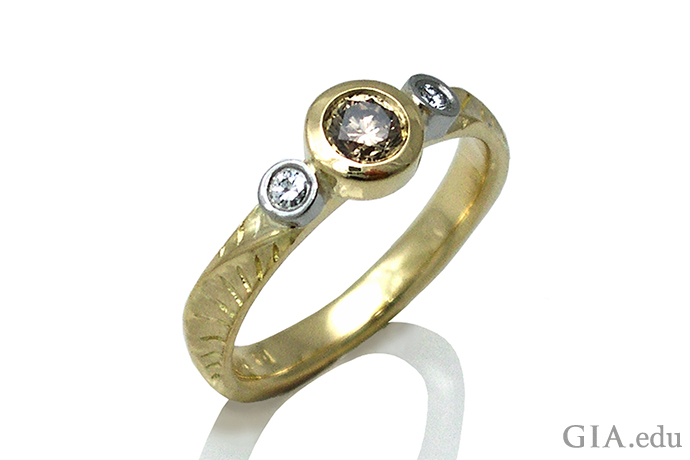
Play ball! Or go hiking, rock climbing or whatever your favorite sport. The center 0.25 ct brown diamond and 0.07 carats of colorless side diamonds are secure in their bezel settings. Courtesy: K. Mita Design
The three stone engagement ring has charmed for centuries – and is now especially chic. Pick a beautiful one, and you’ll have an engagement ring that is timeless.
The three stone engagement ring is hot, and so are these seven other irresistible Engagement Ring Styles.
“Will you marry me?” It’s the ultimate question. You want the marriage proposal to be perfect and the answer to be “yes!” There’s a lot that goes into popping the question. But have no fear. Follow these common tips for how to propose in a few simple steps. (more…)
Many jewelers offer a way to create your own engagement ring featuring the use of semi mount rings. These partially set mountings let you create an engagement ring that is uniquely yours, often more quickly and for less money than a custom engagement ring. (more…)
Ready to propose but not ready to buy an engagement ring? A placeholder ring is a great stand-in while you work out the thousand-and-one details that go into buying your forever engagement ring. Here’s what to consider: (more…)
Gold engagement rings are forever favorites. But how do you pick the right color gold for your ring style and center diamond? Here’s a quick breakdown on gold alloys and what to consider when making this important engagement ring decision. (more…)
Colored gemstone engagement rings are hot. They’re showing up on royalty and celebrities alike. They’re beautiful. They’re unusual. And they can be a great value. Here’s what you need to know when you go shopping.
In this blog, we cover:
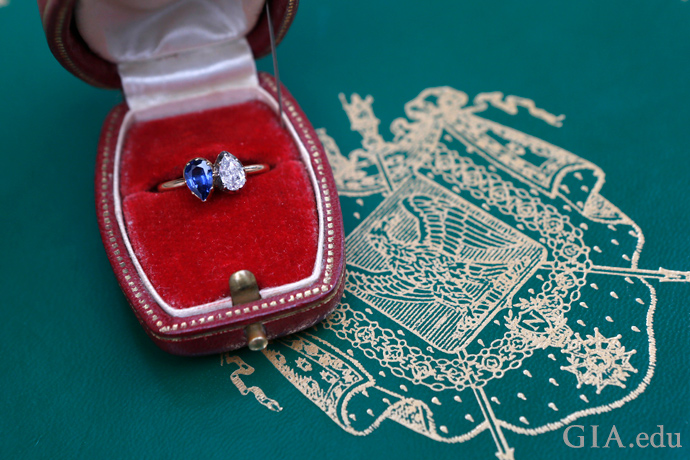
The Empress Josephine toi et moi (“you and me”) engagement ring features a 1 carat (ct) pear shaped sapphire and diamond mounted in 18K gold. Photo: PATRICK KOVARIK. Courtesy: AFP/Getty Images
Colorful gemstone engagement rings are decorating the fingers of royals and other style makers, reviving a not-so-new trend for adding pops of color – and personality – to traditional colorless diamond engagement rings.
Some stylistas are achieving the color-me look with pink, yellow or blue diamonds, while others turn to the world of colored gemstones to find their splash of color.
More than 200 years ago, in 1796, Napoleon Bonaparte gave his future empress, Joséphine, a sapphire and diamond toi et moi (“you and me”) ring for their engagement.
Today, Kate Middleton, the Duchess of Cambridge, wears what is probably the most famous colored gemstone engagement ring. A beautiful creation that once belonged to Princess Diana, it boasts a 12 ct sapphire encircled by diamonds.
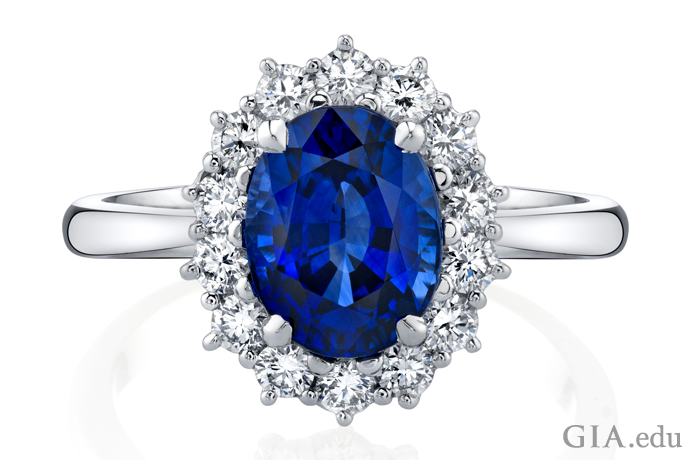
If you like Kate Middleton’s engagement ring, then you’re sure to love this beauty. A 2.73 ct oval sapphire glows the brighter for being accented by 0.56 carats of diamonds. Courtesy: Omi Privé
Kate’s recently engaged cousin by marriage, Princess Eugenie, daughter of Prince Andrew and Sarah Ferguson, opted for a slightly orangy pink padparadscha sapphire, surrounded by round brilliant cut diamonds. The style somewhat resembles the engagement ring her mother (the Duchess of York) received – a ruby with a halo of diamonds.
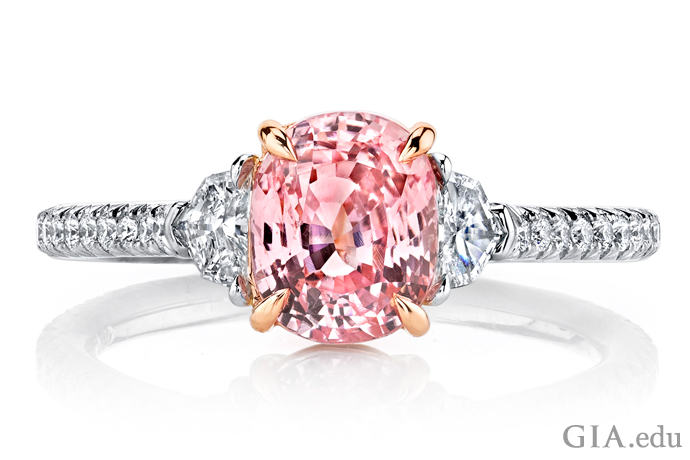
Like Princess Eugenie’s engagement ring, this 2.02 ct padparadscha sapphire and diamond ring is both beautiful and unusual. Courtesy: Omi Privé
In the celebrity world, actress Jenny McCarthy wears a 10 ct yellow sapphire engagement ring framed by diamonds. Ashlee Simpson’s vintage-style ring features a marquise diamond surrounded by calibré cut rubies. Elizabeth Hurley sports a 9 ct blue sapphire framed by two trilliant cut diamonds in a classic design.
For these trendsetters – and many other brides – incorporating colored gemstones into an engagement ring offers myriad options to display their individual style and personality. It’s a look that’s both timeless and contemporary.
There’s a lot to love about colored gemstone engagement rings. First, there’s the obvious: color. Explore the world of colored gems and you’ll find a rainbow, from the deep reds of ruby and blues of sapphire, to the grassy greens of tsavorite garnet and kaleidoscopic colors of spinel. There’s a gem for every hue imaginable.
Second, with colored gemstones you can add more depth of meaning to the engagement ring. For example, you could include your birthstone and your partner’s birthstone, alone or with diamonds. Colored gemstones also come with historic symbolism, and you could pick one that inspires you. Take sapphire – it has traditionally been associated with sincerity, truth and faithfulness.
You can also use colored gemstones to send secret messages. The Victorians turned this into an art form with acrostic jewelry – using the first letter of each gemstone to spell a word. For example, a diamond, emerald, amethyst and ruby set together would spell the word “dear.” Acrostic jewelry can also be designed to spell birthdays, private messages or a secret shared between you and your beloved.
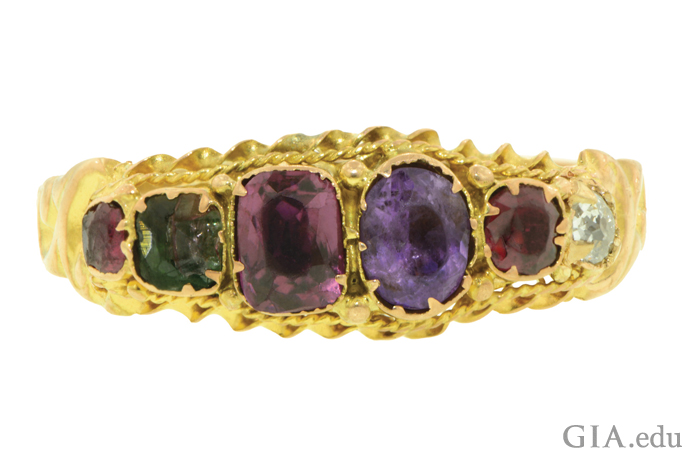
This acrostic ring was made in England during the Victorian era (1837–1901). The gems spell “regard” from left to right: ruby, emerald, garnet, amethyst, ruby and diamond. Courtesy: Doyle & Doyle
Finally, there’s affordability. Colored gemstones are a great way to add size to an engagement ring. This is especially true if you look beyond rubies and sapphires toward gems that are less well known but equally as beautiful – and usually significantly less expensive. Examples include the pink beryl morganite, the many colors of spinel and tourmaline, or intense green, red or orange garnets.
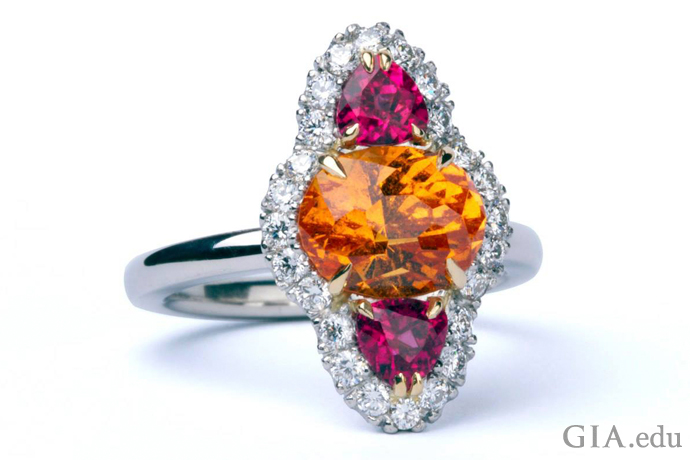
If your bride-to-be’s favorite colors are orange and pink, this ring featuring a spessartine garnet center stone cut by John Dyer, pink tourmaline side stones and diamond melee is sure to please. Courtesy: John Dyer & Co.

The color of morganite can be very similar to that of a pink diamond, but this 7.07 ct morganite is a striking – and more affordable – option. Courtesy: 1stdibs.com
Morganite engagement rings are recent favorites with brides-to-be – and for good reason. Pink has traditionally been the color of romance, and morganite ranges from pastel pink to purplish, yellowish or orangy pink. Similar hues are seen in pink diamonds, but you can have a large, attractive morganite for a small fraction of their cost.
Blue zircon, with its high dispersion, is often mistaken for blue diamonds. Yet while the cost of even a 1 ct blue diamond would be prohibitive for most buyers, a 3 or 4 ct blue zircon engagement ring is obtainable for far less than an average month’s salary.
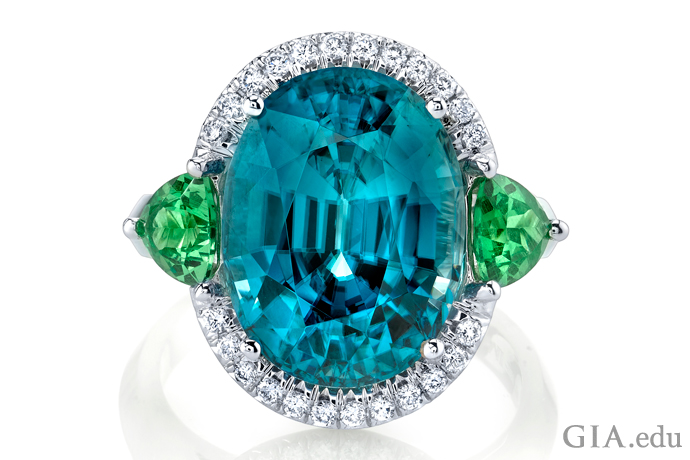
Find beauty in blue with this 6.74 ct cushion cut zircon ring accented with trilliant cut tsavorite garnet side stones and round brilliant cut diamonds set in 18K white gold. Courtesy: Omi Privé
Spinel and tourmaline are two other gems that offer a wide range of color options and great value. They occur in colors that are very similar to those of fine ruby or sapphire, but a top-quality 5 ct red tourmaline (rubellite) could be purchased for less than a third of the cost of a comparable 2 ct ruby – delivering more bling for your buck.
One of the most exciting, if less well known, colored gemstones seen in engagement rings is the green garnet known as tsavorite. More durable and often brighter than emerald, whose color it mimics, a fine tsavorite garnet is usually less expensive than its counterpart.

An alternative and more durable option than emerald, this 2.86 ct tsavorite ring with diamond accents stands out from the crowd. Photo: Emily Lane/GIA. Courtesy: Sara and Bret Keller
With so many different colored gemstones available, your challenge will be finding one that sets your heart aflame – and making sure the gem is tough enough for daily wear.
Durability is a major consideration when searching for an engagement ring gemstone. The gem you choose must withstand the bumps and bangs of daily wear, plus the effects of heat, light, household chemicals and low or high humidity. Different gemstones have different properties and, as a result, different tolerances to these stressors.
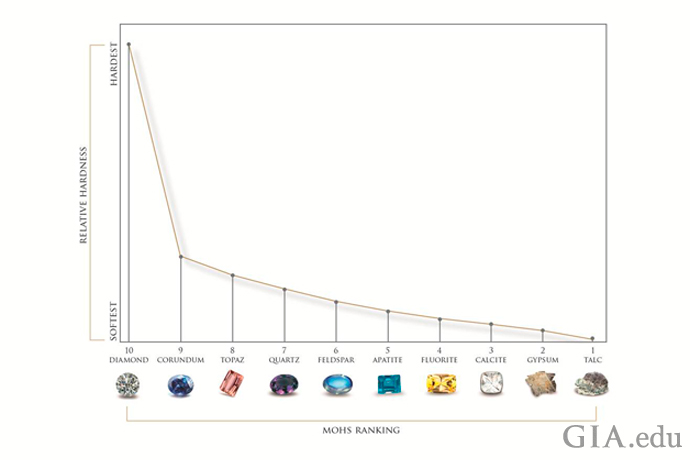
Introduced in the early 19th century, the Mohs scale ranks gem and mineral hardness in a range from 1 (least hard – talc) to 10 (hardest of all – diamond). Illustration: GIA
One aspect of gemstone durability is hardness. The Mohs scale ranks gem and mineral hardness on a scale of 1 (least hard – talc) to 10 (hardest of all – diamond). Ruby and sapphire rank 9, meaning they are able to resist scratching and abrasions. This makes them great choices for engagement rings that will see a lifetime of active wear. Although less hard, spinel (8), morganite (7.5–8), zircon (7.5), and tsavorite garnet and tourmaline (both 7–7.5) are considered durable enough for everyday wear provided care is exercised (no rock climbing!).
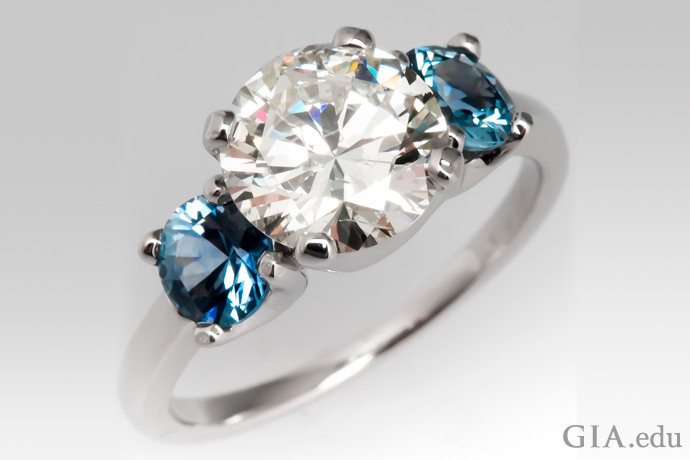
Two Montana sapphires weighing a total of 1.19 carats bookend a 2.05 ct round brilliant diamond. Courtesy: EraGem.com
Toughness and stability are two additional factors that determine a gemstone’s durability.
Toughness indicates how well a gemstone resists breaking, chipping or cracking. The way the atoms of a gem bond together and the strength of these bonds determine gemstone toughness. Examples of not-so-tough gems are opal and tanzanite which, if set in rings, are best reserved for special occasions – not everyday wear.
Stability refers to how well a gemstone can withstand exposure to chemicals, light and changes in temperature or humidity. Extreme temperature changes can damage some gems like opal and tanzanite. Opals can crack or craze in low humidity or with exposure to heat. Citrine, amethyst and topaz may fade or change color from prolonged exposure to sunlight. Light and/or heat can also negatively affect most organic gems – such as pearls, coral and amber – as will exposure to household chemicals.

Tanzanite is a beautiful gem that calls for special occasions. At 6 to 7 on the Mohs scale with fair-to-poor toughness, it’s not ideal for an engagement ring that will see a lifetime of daily wear. Courtesy: Omi Privé
It’s important to note that many colored gemstones are routinely treated to improve their color and/or clarity. Designed to bring out the inherent beauty of a gem, many of these treatments are widely accepted in the gem trade. However, you should be aware that some treatments can also affect stability. As a result, your gem may require special care.
For example, treatments such as coating and fracture filling can be removed by heat and strong chemicals. Although emerald ranks 7.5–8 on the Mohs scale, it is not a tough gem and is often treated with oil and/or resin to improve clarity. This treatment also disguises fractures in the stone that can cause it to break if banged against a hard surface. If you have your heart set on a green gemstone engagement ring you plan to wear every day, you might want to consider a more durable tsavorite garnet instead, reserving emeralds for earrings or pendants. Garnets are rarely treated and have good toughness.
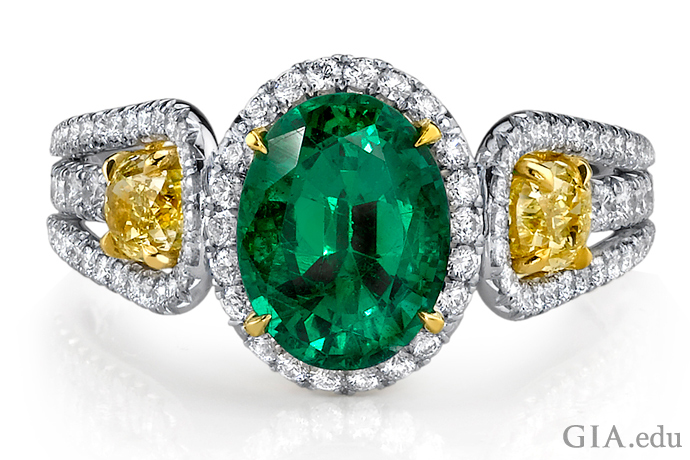
A halo of diamonds creates contrast with the emerald and helps protect this popular but fragile stone. Two yellow diamonds add more color and drama to the ring. Courtesy: Omi Privé.
Color is king
Like colorless diamonds, the quality of a colored gemstone is determined by a combination of the 4Cs: color, clarity, cut and carat weight. For colored gems, however, color is by far the most important factor. In some cases, such as whether a gem is called pink sapphire or ruby, or green beryl or emerald, the distinction may be made based on color alone. Clarity is important, but for most colored gems there is no universal grading system or set of standards to evaluate clarity. And cut may vary greatly from stone to stone. The goal is typically to maximize size and color – or, as in the case of fantasy cuts, to create a work of art.
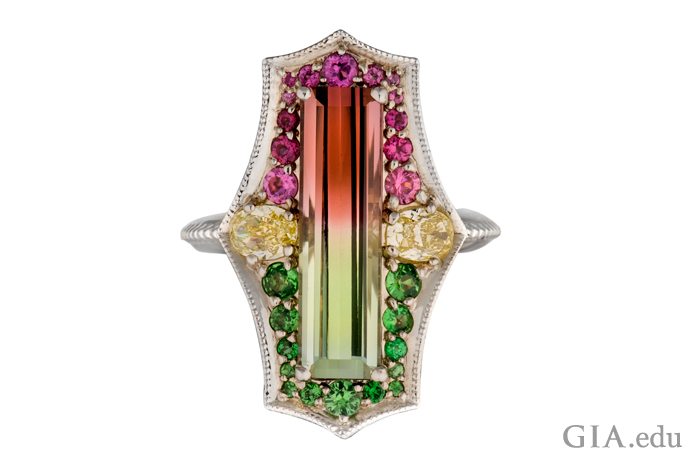
A piece of art to stand the test of time, this 9.05 ct bi-colored tourmaline ring set in 14K white gold features yellow diamonds, tsavorites and rubellites. Photo: Orasa Weldon/GIA. Gift of Derek Katzenbach. In Memory of Nicholas Scott Golden, University of Maine geology student.
There are, however, some important considerations to look for when assessing the quality of a colored gemstone in addition to the durability factors discussed above. Many gems show more than one color. This can be an asset in a bi-colored tourmaline – for the bride-to-be who wants a truly unique colored stone engagement ring.
In other gems, such as blue sapphire, colorless zones seen on close inspection may detract from the overall appearance of the gem. And while high clarity is desirable in most colored gems, as it is in diamonds, a few identifying inclusions in an inconspicuous area (such as the culet) may ensure that the colored gem is natural (not synthetic) and untreated.
Optical phenomena
Colored gemstones also offer the possibility of certain phenomena, such as chatoyancy (the cat’s-eye effect) and asterism (a star), that are not seen in diamonds. These phenomena are caused by the reflection of light off dense inclusions of minerals in gems cut as cabochons. Such phenomenal stones provide exciting design options for a colored gemstone engagement ring.

This 7.57 ct cat’s-eye chrysoberyl seems to symbolize two lives united as one. Add a sparkling halo of round brilliant cut diamonds for strength and you have the perfect sentiment for an engagement ring. Photo: Robert Weldon/GIA. Courtesy: Richard Krementz Gemstones
Where the gem comes from
For some gems, such as ruby and sapphire, country of origin may also play a significant role in determining value. For example, a ruby from Myanmar (“Burmese” ruby) can cost significantly more than a comparable ruby from another locality, such as Mozambique. Similarly, there is a premium for sapphires from Kashmir, due to both their distinctive “cornflower blue” color and their rarity: There has not been major production from this region for more than a century.
Who owned it before
Another important factor in determining price is historical provenance. An antique or vintage colored gemstone engagement ring may come with its own story, and that story may have value. In one of the most striking examples, when the Empress Josephine sapphire and diamond engagement ring mentioned above was offered at auction in 2013, the auction house estimated its value at $20,000 based largely on the gems alone. Ultimately, the winning bidder paid more than $1 million – a huge premium for the ring’s storied association with Napoleon Bonaparte and his first bride.
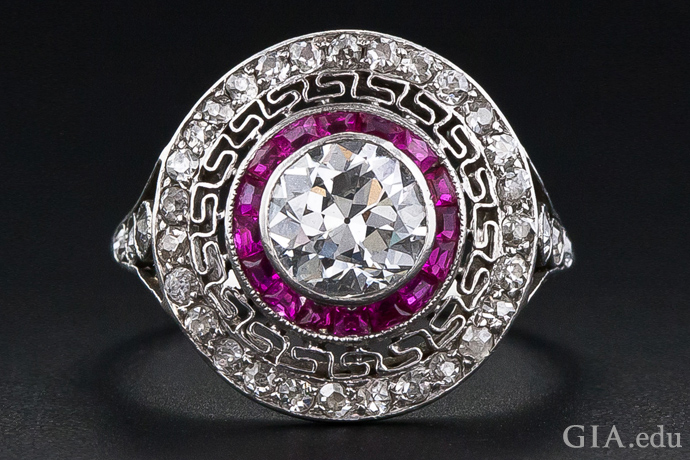
A ring of Burmese rubies encircles an Old European cut diamond in this Art Deco–era ring. A Greek key motif made of platinum circles the rubies, while another ring of diamonds completes the design. Courtesy: LangAntiques.com
Quality and rarity drive value
Like diamonds, colored gems of high quality are rare, so buyers typically pay a premium for top-quality colored stones. Once you’ve decided on a gemstone for your engagement ring, it pays to comparison shop to understand its quality factors and how they affect value. You should also learn as much as you can about your gemstone of choice. GIA’s Gem Encyclopedia is a good place to start. It provides in-depth information for 29 of the most popular gems on the market. You’ll also find detailed buying guides for each gem describing the specific qualities to look for, the gem’s durability, common treatments and more.
After you’ve purchased your colored gemstone engagement ring, you’ll want to keep it like new. The right way to clean it will vary depending on the gem material you’ve chosen and whether or not it’s been treated. Usually, gentle cleaning solutions specially formulated for delicate gems – or just warm, soapy water and a soft cloth – are all you need. If you’re uncertain about the durability of your gem, avoid using ultrasonic cleaners and off-the-shelf cleaning solutions.
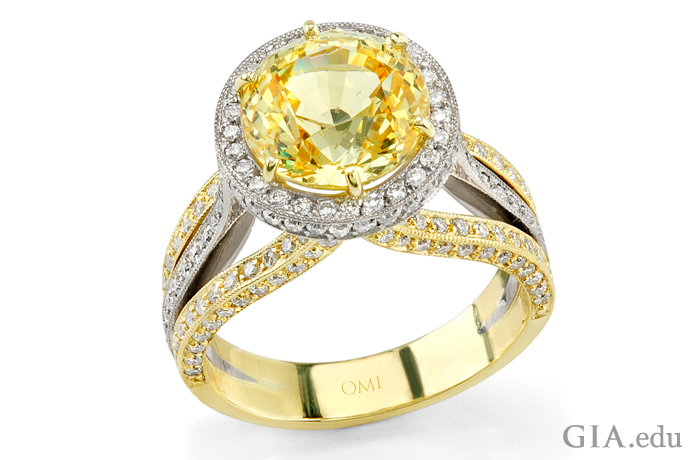
Washing with warm, soapy water is the safest way to clean this 5.11 ct yellow sapphire engagement ring, which is surrounded by 128 round diamonds weighing 0.75 carats. Courtesy: Omi Privé
Engagement ring settings must secure the gems they hold as well as show them to their best advantage. Bezels, halos and other protective settings can play an important role in preventing the chipping or cracking of colored gemstones. But who said practical can’t also be beautiful? Settings serve as an essential design element, defining an engagement ring’s style and overall look. Settings let you introduce contrasts in color or harmonize them to get just the right amount of color pop in your ring. Consider these examples:
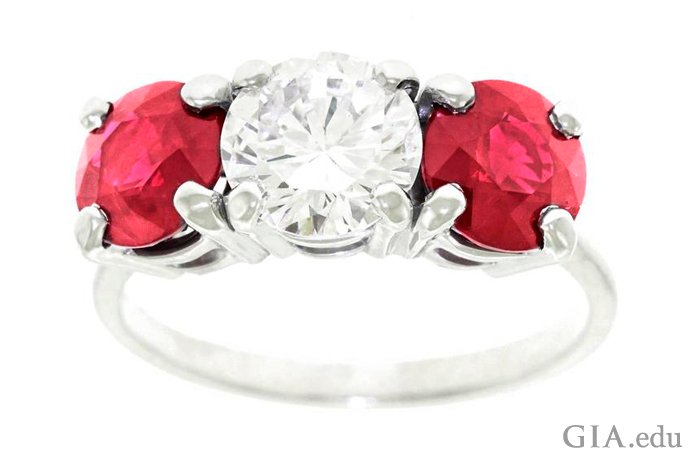
Create a fiery look in an engagement ring by using this three-stone ring for inspiration. The two rubies (1.41 ct and 1.37 ct) bracketing the 1.39 ct round brilliant diamond are sure to catch the eye. Courtesy: 1stdibs.com

Need more proof that colored gemstones can bring excitement to an engagement ring? This stunning creation features a 2.57 ct spinel encircled by 0.20 carats of round diamonds. Courtesy: Omi Privé

The diamond and sapphire in this Victorian-era bypass ring make for a delicate pairing. Courtesy: Treasurly by Dima
Jewelry designers are putting a contemporary stamp on three-stone, halo and bypass rings with colored gemstones. Their modern updates are a beautiful melding of past and present – pieces that pop with color and life. Look around and you’ll find a number of creative interpretations.
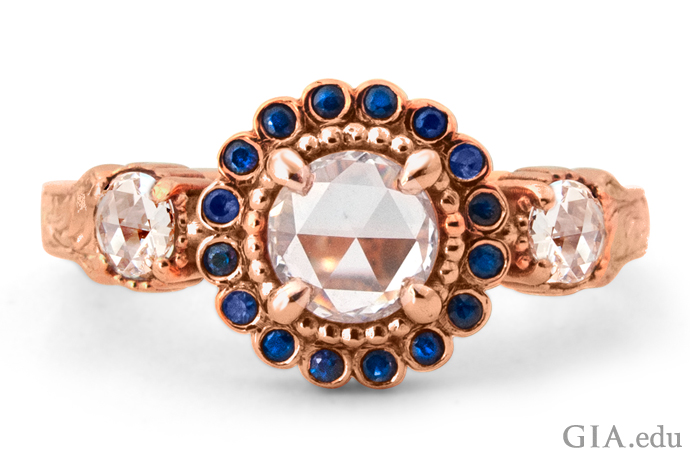
Something old. Something new. Something borrowed. Something blue. Blue sapphires surround a rose cut diamond in this modern ring with a design borrowed from the Victorian era. Courtesy: Shelly Purdy Studio
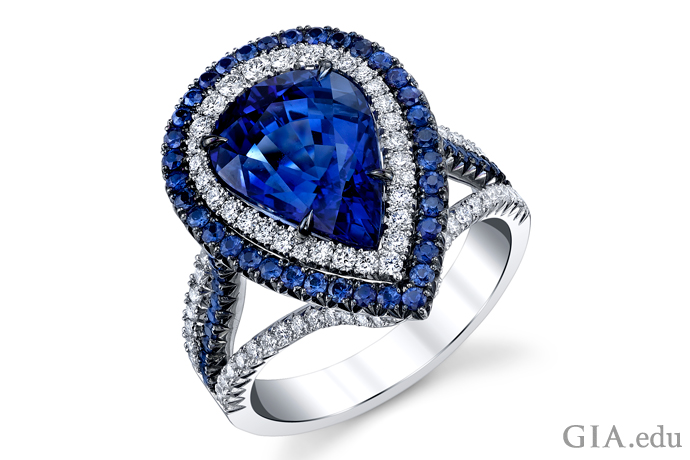
A pear shaped sapphire is surrounded by colorless diamonds and a second halo of sapphires. Diamonds and sapphires spill down the shank of the ring. The bold contrasting colors create a visual richness sure to please. Courtesy: Omi Privé
Now that you know about colored gemstone engagement rings, you’re ready to start shopping. But where? The GIA Retailer Look Up lets you easily find local retailers who have GIA-trained staff to help you through your gemstone selection process.
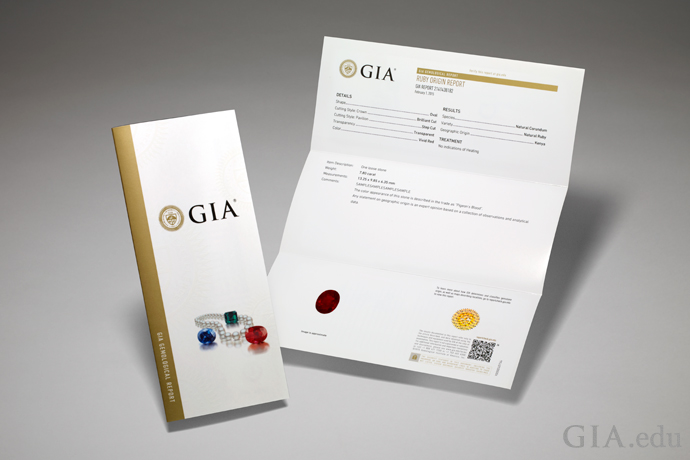
Before you decide on a colored gemstone engagement ring, ask for a GIA Colored Stone Identification Report.
To make sure you get the best value, ask for an unbiased GIA Colored Stone Identification Report. The report will validate the gem’s identity and include detailed descriptions of its size, color and measurements, along with a color photograph. The report will also indicate whether the gem has been treated and, if it has, identify the type of treatment – important to knowing how to care for your gem. Depending on the gemstone, you may also be able to get information on its geographic origin.
Need more inspiration for colorful engagement rings? Read our article on how to buy antique and vintage engagement rings for some exciting examples.
A yellow diamond engagement ring is a stunning choice to celebrate your love. But picking the perfect engagement ring requires knowing about yellow diamonds, mountings, the effect of metals on appearance, treatments and more. We offer help.
Here are a few things you’ll need to know:
A fancy-color yellow diamond falls outside the GIA D-to-Z color range
GIA assigns one of six “fancy” color grades to your yellow diamond engagement ring
Don’t expect a round diamond for your yellow diamond engagement ring
Mountings can make a yellow diamond look darker
The metal used affects the appearance of a yellow diamond engagement ring
Some yellow diamonds might be treated, lab grown or both
Make sure GIA grades the diamond in your yellow diamond engagement ring
A yellow diamond engagement ring is rare because yellow diamonds are rare
Understanding diamond color is essential before you go shopping for a yellow diamond engagement ring. Most colorless or near-colorless gem-quality diamonds are graded based on the absence of color, using GIA’s D-to-Z diamond color-grading system. Yellow diamonds are considered to be colored diamonds and are graded as “fancy” when they have more color than the Z masterstone.
Here is another important difference between yellow diamonds and colorless diamonds. Diamonds in the D-to-Z range usually decrease in value as the color becomes more obvious. The opposite happens with fancy-color diamonds. Their value generally increases with the strength and purity of the color.
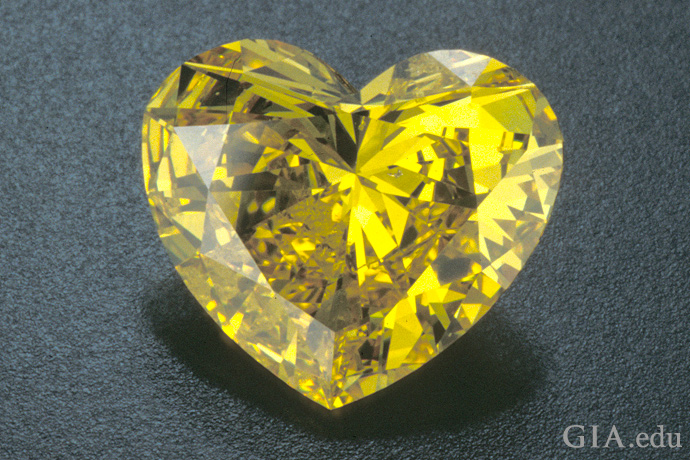
Colored diamonds graded Fancy Intense are often prized over those with other fancy grades. This yellow heart shaped diamond speaks of the first blush of love. Photo: Robert Weldon/GIA

Fancy-color diamonds are often cut into fancy shapes, like a pear shape, to bring out the color. Sunny days lie ahead for the bride wearing this 5.33 carat (ct) Fancy Yellow pear shaped diamond. Courtesy: 1stdibs.com
The names used to describe colors are often quite subjective. Consider that the color yellow includes variations like butter, lemon, golden and more. To bring objectivity and standardization to the grading of the rare beauties that are colored diamonds, GIA created the GIA Colored Diamond Color Grading System in the 1950s and refined it over the decades. This grading system not only defined the processes for determining a diamond’s color, but it also established the terms, or color grades, for describing it.
GIA’s grading system places most colored diamond in one of nine categories based on the diamond’s hue, tone and saturation: Faint, Very Light, Light, Fancy Light, Fancy, Fancy Intense, Fancy Dark, Fancy Deep and Fancy Vivid. The first three grades aren’t used for yellow diamonds, so the scale for yellow begins with Fancy Light. The majority of yellow diamonds in the jewelry industry are graded Fancy Light, Fancy, Fancy Intense and Fancy Vivid.
In general, the more color a colored diamond has, the better. Fancy Deep and Fancy Vivid diamonds, for example, have more color than Fancy Light diamonds—and are usually more valuable. However, tone (the degree of darkness or lightness of a color) is also important. For example, a diamond that is extremely dark (Fancy Dark) may be less desirable than a lighter stone graded Fancy Intense.
It is not unusual for a yellow diamond to have a hue modifier, such as orangy yellow or greenish yellow. A modifier does not indicate that the color is any less strong or pure.

This chart shows the subtle transitions in GIA’s color grading of yellow diamonds. Note, too, that the fancy grades represent a range of color sensations, not a “single” color sensation. Photo: Elizabeth Schrader and C. D. Mengason/GIA
Round diamonds cut in the brilliant faceting style are the most popular diamonds for engagement rings, but you may have a challenging time finding a round stone for your yellow diamond engagement ring. That’s because yellow diamonds typically display a more intense face-up color appearance when they’re cut in a shape other than round. These non-round shapes are called fancy shapes, which include oval, pear, marquise and heart, plus square or rectangular cuts like princess, radiant and emerald.

This 10.12 ct Fancy Vivid yellow pear shape is an example of a fancy-shape diamond. This shape was most likely selected to intensify the yellow color. Photo: Elizabeth Schrader/GIA. Courtesy: The Scarselli Family
If your heart is set on a yellow diamond engagement ring, you will probably look at a number of loose yellow diamonds. Be aware that the yellow diamond that has caught your eye may appear darker when set in a mounting.
Look at the photos below. The diamond on the left in the top image was graded Y–Z range, just on the light yellow/Fancy Light yellow boundary. It is shown next to a Fancy yellow reference diamond. In the bottom image, the larger diamond is mounted in a ring and placed next to the same reference diamond.
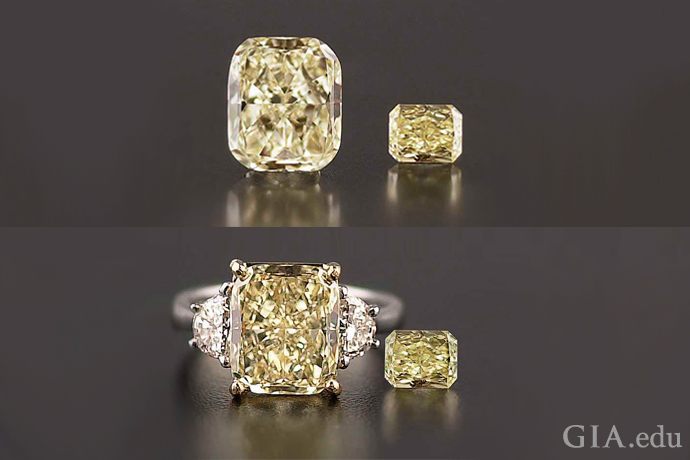
A yellow diamond is likely to look darker once it’s set in a mounting. Photos: Elizabeth Schrader/GIA. Courtesy: The Scarselli Family
This effect can actually work to your advantage, particularly if you’re deciding between a less expensive “light yellow” diamond at the very low end of the D-to-Z color scale and a more expensive Fancy yellow diamond.
Diamonds are highly reflective. Their facets are like tiny mirrors, reflecting their surroundings, which include the color of the ring and the prongs holding the gem. Because of this, the color of the metal will affect a diamond’s appearance.
You’ll typically have three choices when picking a metal for your yellow diamond engagement ring:
Do you want your engagement ring to highlight the color of the yellow diamond? White metals and rose gold will create contrast between the mounting and the stone. White gold makes for a streamlined, sophisticated look. A rose gold mounting will create a warmer contrast.
Do you want your ring to complement the color of the diamond? A yellow gold mounting will harmonize with a yellow diamond. Take a look at Art Deco style engagement rings, Retro style engagement rings and ring styles typical of the Victorian era, times when yellow gold was in fashion, to see if these are designs you’d like to recreate for your yellow diamond engagement ring.
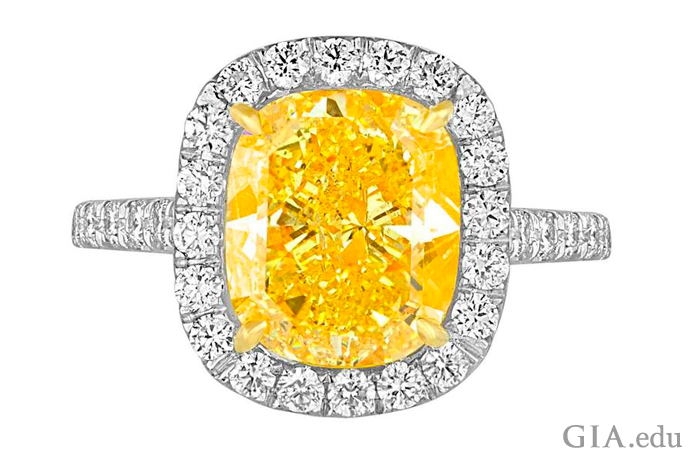
Want your yellow diamond to pop? Set it in a white metal ring. This 4.76 ct Fancy Vivid yellow diamond is so bright that it appears to have captured a ray of the sun. A halo of colorless diamonds surrounds it. Courtesy: 1stdibs.com

Rose gold is another way to create contrast with a yellow diamond. In this ring, it acts as a subtle counterpoint to the 3.46 ct yellow oval diamond. Courtesy: 1stdibs.com
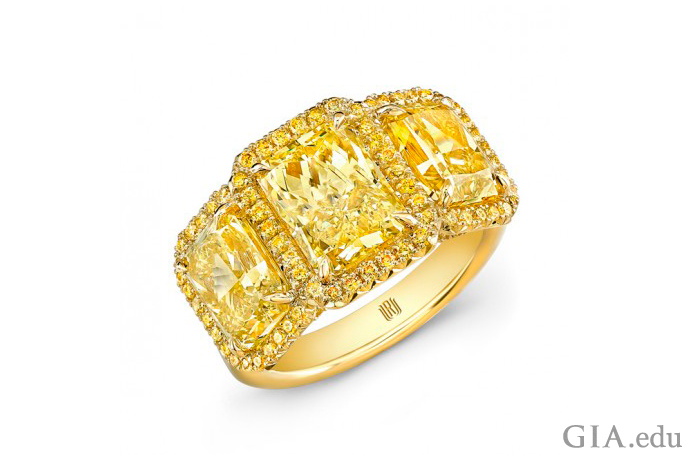
A yellow gold band paired with yellow diamonds creates a harmonious look. The three yellow diamonds set in 18K yellow gold are sure to soothe the eye as they captivate it. Courtesy: Rahaminov Diamonds
Off-color diamonds that are brownish or yellowish can be treated to modify their color. Manufacturers typically use one or both of two different processes:
In both cases, the treatment is considered permanent under normal conditions of wear and care. Non-permanent treatments, like coatings, are also possible. All else being equal, diamonds that have not been treated are more expensive than diamonds that have been treated. Legally, the seller must disclose any treatments. GIA can detect these treatments, and it identifies them in the GIA Colored Diamond Grading Report. It also laser inscribes “HPHT PROCESSED” or “IRRADIATED” on the girdle of diamonds treated by either of these methods.

This 22.27 ct Fancy Vivid yellow emerald cut diamond was identified as artificially irradiated and annealed. Treated diamonds of this size and this attractively saturated color are rare. Photo: Sood OIl (Judy) Chia/GIA
Synthetic yellow diamonds – with properties that match their natural counterparts – are also being manufactured. The first synthetic diamonds were grown by HPHT processes that mimic the high-pressure, high-temperature conditions of natural diamond formation in the earth. Today, chemical vapor deposition (CVD) is another common method whereby synthetic diamonds are grown in an apparatus that uses high temperatures and low pressures in a vacuum chamber. The CVD process involves heating a mixture of a hydrocarbon gas (such as methane) and hydrogen, which releases carbon atoms that then settle onto the cooler, typically square-shaped seed plate of natural or, more likely, synthetic diamond. With both techniques, subsequent treatments may be used to change the color of the original crystal.
GIA can detect synthetic diamonds grown using either HPHT or CVD, and it issues distinctive reports for these synthetic or lab-grown diamonds. The GIA Synthetic Colored Diamond Grading Report offers the same information as the GIA Colored Diamond Grading Report issued for a natural diamond (see below), but it provides a more general description of the color and clarity. For additional disclosure and identification, GIA laser inscribes the diamond’s girdle with the stone’s unique report number and a statement that it is laboratory grown. The report itself looks markedly different from those issued for natural diamonds.

This 0.40 ct square-shaped diamond was grown using the CVD process. Photo: Sood OIl (Judy) Chia/GIA
A yellow diamond engagement ring is a symbol of your love. It’s also a significant emotional and financial investment. So you’ll want to make sure the diamond is graded by a trusted, unbiased lab like GIA. GIA’s meticulous grading process involves testing to determine whether the diamond is natural or lab grown and to identify any known treatments used to enhance its appearance.
Highly trained colored-diamond graders observe the diamond face-up using controlled lighting in a specially designed viewing box that eliminates distractions and shields the stone from external light. These specialists determine the diamond’s characteristic color based on a combination of its size, shape, faceting arrangement and color. They then bracket the diamond using side-by-side comparisons under the same lighting conditions with two or more color references. On the basis of these comparisons, they select one of 27 hues (such as orangy yellow, yellow or greenish yellow) and assign a specific “fancy” grade based on the hue’s tone and saturation.
A GIA Colored Diamond Grading Report provides a full quality assessment of a colored diamond including the color grade, color origin (natural or treated), carat weight, clarity and a plotting diagram of its clarity characteristics. As an optional service, a full-color image of the diamond may also be included.

A GIA Colored Diamond Grading Report is your assurance that your yellow diamond is a natural diamond, graded to GIA’s exacting standards. It also provides full disclosure of any known treatments discovered during the grading process. Photo: GIA

If you’re looking for a unique engagement ring, this 2.03 ct Fancy Vivid yellow cushion cut diamond set in platinum will surely stand out. Courtesy: EraGem.com
When you wear a yellow diamond engagement ring, you’ll have something unusual on your finger. In the early 2000s, for example, yellow diamonds represented only 2.4% of all diamonds submitted to GIA for various grading reports over the course of a single year. If unearthing a diamond is noteworthy, then discovering a yellow diamond is like finding a golden needle in a haystack.
Still yearning for a yellow diamond engagement ring? Dig a little deeper to learn more about yellow diamonds.